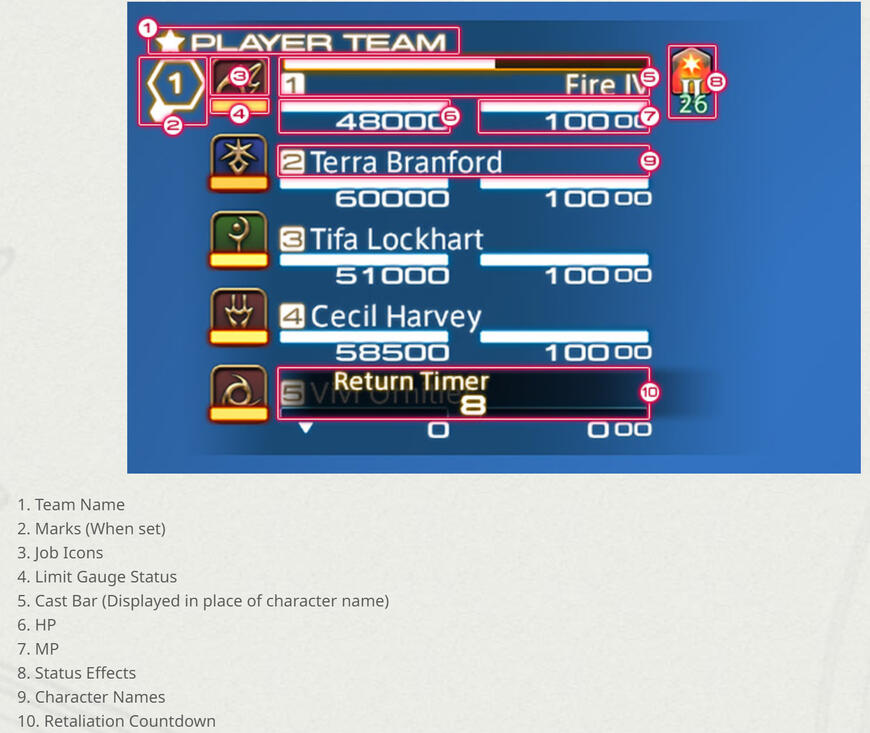A Comprehensive Guide to Crystalline Conflict
This guide is intended to provide an overview of CC for beginners and intermediate players alike. It is a work in progress! Please check back for updates.
Class Guides
Tanks
Healers
Melee DPS
Physical Ranged DPS
Magical Ranged DPS
Terms
AoE - Area of Effect
Burst – High damage in a short amount of time
CC - Crystalline Conflict
cc - Crowd Control
CCRC - Crystalline Conflict Regional Championship 2023 (FanFest CC Tourney)
CD - Cool Down
DoT - Damage over Time, abilities that deal periodic damage over a set amount of time rather than upfront
Elixir - Standard Issue Elixir skill that restores full HP and MP
FRC - The Feast Regional Championship 2018 (FanFest Feast Tourney)
Gank - To kill someone, typically as a target of opportunity
LB - Limit Break
LP - Light Party, a holdover term from the Feast days, this means organized team play which you can do in duty finder. This typically applies to tournament play.
LoS - Line of Sight
MM - Matchmaking
MoN/Poly/Imp - All terms used to describe White Mage's Miracle of Nature ability which is the most powerful cc in the game.
Morb - A reference to the movie nobody has watched, means to play exceptionally well in a match, usually killing many enemies
Rat - To go deep behind enemy lines with the goal of denying elixirs, drawing multiple enemies away from the team fight, or general harassment
Recupe - Recuperate, the skill that heals you at the cost of MP
Scrimms - Custom practice matches organized by LP teams or community events
Skittle/Orbs - The red orbs left on the Volcano map after an explosion
SoloQ - Short for Solo Queue, playing Crystalline Conflict, typically with reference to ranked play
Snapshot - When an ability registers its execution with the server
Wise Man - Began as a meme in the revival discord, it means pushing the crystal, sometimes because the other team isn’t paying enough attention to it
About & Dedication
About
My guide project began just two weeks after CC came out. I deeply enjoyed the game mode but was also frustrated that there didn’t seem to be any centralized guide to learn from. As a nerd who likes to read things to improve, I decided I’d set out to write the thing I wish someone else had. (Be the change you want to see in the world and all that.)Since then, the original guide which came to span some 40 pages became fairly outdated as metas shifted and the PvP community began to adapt to the game mode. Rather than attempt to re-write the whole thing with my average knowledge of each class, I figured for the purposes of this major revision it would be much better to have the real experts write the guides for their classes. Wherever possible I sought out the top players of the (primarily Crystal) data center for each class to write their own guide. Classes I couldn’t get authors for have been written by myself and reviewed by a community of strong players to help flesh out.In migrating the guide out of a unwieldy google document and into an unwieldy-but-prettier Carrd page the project is moving in stages. The website is currently working through Stage 1.Stages:
1) Guides are written and uploaded for each class in at least a text only format.
2) Images are uploaded to each guide making them more visually appealing and easier to digest.
3) Images linked to FFXIV API to utilize Lodestone’s ability descriptions, futureproofing class changes
4) Videos are uploaded (or linked) to help break out certain concepts or provide examples where possible.There are many people I am indebted to through this project, and each person who was willing to be identified has had their name listed at the bottom of their page. Those who wished to remain anonymous have been marked as such.
Dedication
This project is dedicated in memory of Tony Pajamas, one of the first editors of the original guide. Tony Pajamas, real name Clayton Hightower, was a member of the FFXIV PvP community and an American Marine Corps combat veteran. He believed strongly in the national sovereignty of Ukraine and had served there prior to the renewed Russian invasion of 2022. Well aware of the risks, he chose to serve again in this war believing that it was better for a veteran such as himself to fight than for some poor 18-year-old to be drafted in his place. In December 2022 he was killed in action while performing life-saving CPR on a downed squadmate under fire. Tony was an incredibly charismatic and outrageously hilarious person. He was often found burning away the midnight oil in voice chat with many of us, spinning a yarn about his crazy life experiences and keeping us all laughing. We are led to believe he did much the same for the squad with which he fought.Tony is incredibly missed by the community and his heroism and example will be remembered by us all. Till Valhala, brother.Slava Ukraini, Heroyam Slava.
-Verre Bellareve, Mateus
The Square Enix CC guide (linked above) does an excellent job of running through the basics. If you are absolutely new to the mode I highly suggest reviewing it for guidance on Maps, Map Events, Items, User Interface, and the Progress Bar.All of these will be incredibly important to playing the game.

Worth drawing extra attention to is the LB bar under the portrait of any player's job icon. This is #4 in the image above. LBs are essential to winning team fights and have major game changing potential. To play well, you'll need to be alert to both your team and your enemy's bars, especially when full!